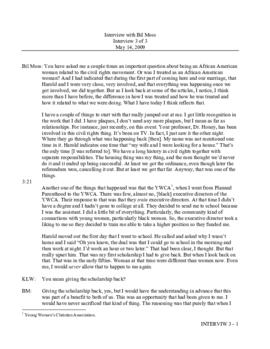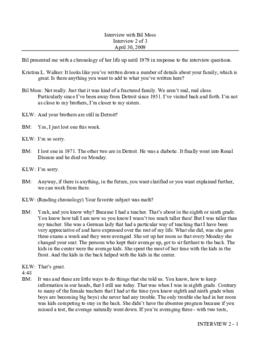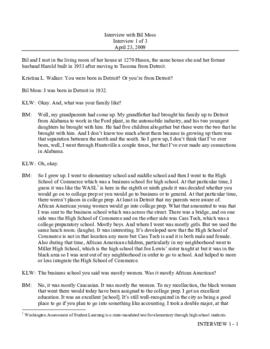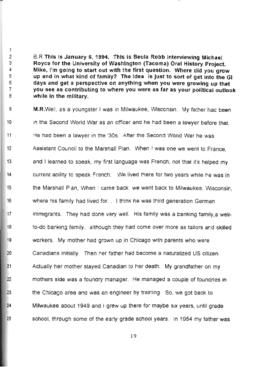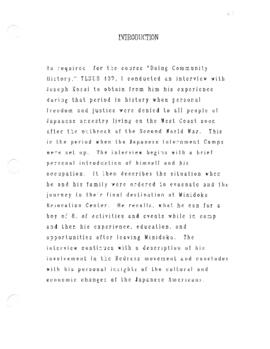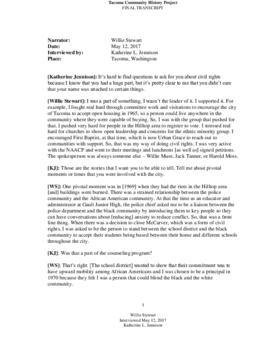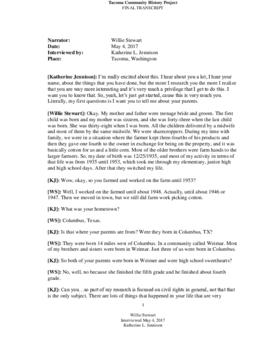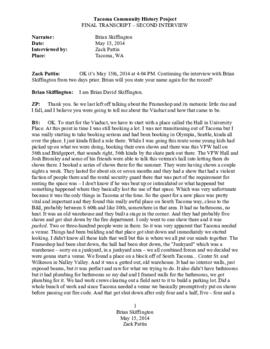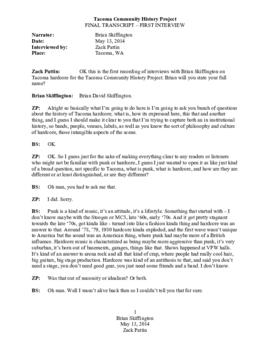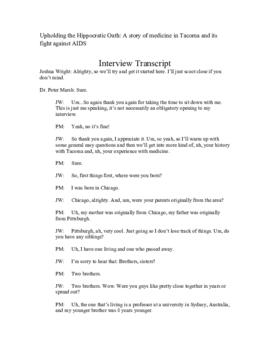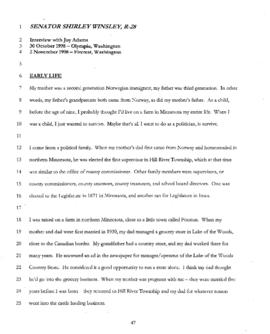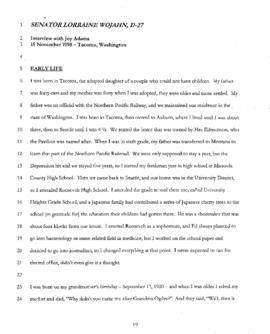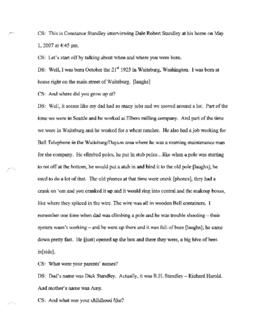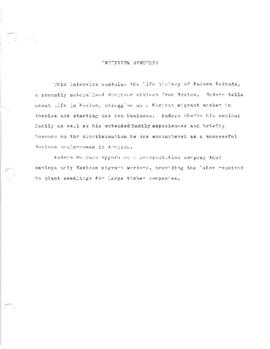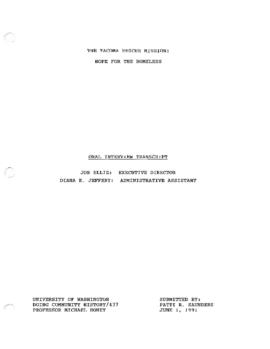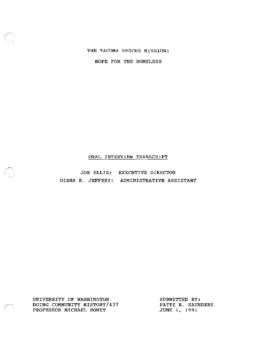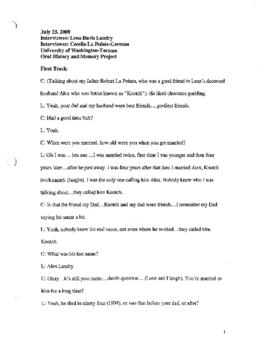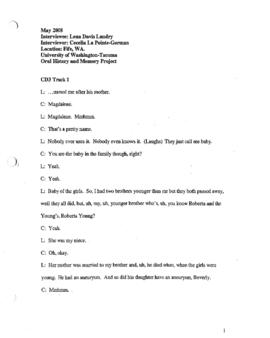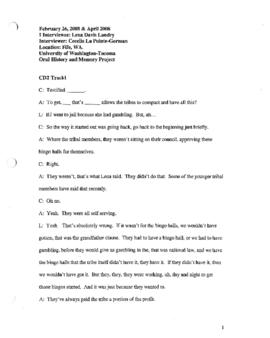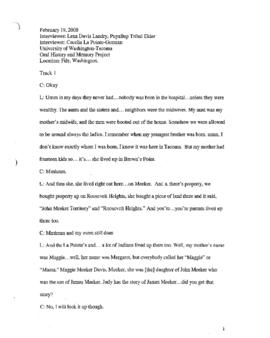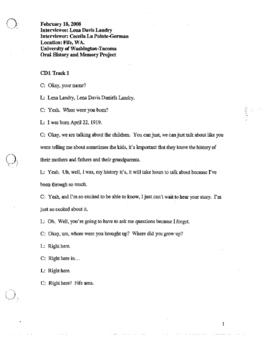- Series
Showing 230 results
Collections153 results with digital objects Show results with digital objects
Women and Tacomas Civil Rights Movement: Mrs. Bil Moss
- File
- 2009
Oral history interview with Bil Moss by Kristina L. Walker conducted April - May 2009. Community leader Bil Moss looks back at six decades of social activism and discusses her involvement in Tacomas civil rights movement. She describes her early work to secure open housing in Tacoma, which arose from her personal struggles to purchase property outside the Hilltop area, and her work with the Tacoma Chapter of the Links on the Sickle Cell Project. Moss touches on a number of her civic and political activities in these three lengthy interviews and shares some insights into the social barriers she has faced as an African-American woman.
Winning the Hearst and Minds of Fort Lewis and McChord GIs During the Vietnam Era
- Item
- 1994
Oral history interview with Michael Royce by Beula Robb conducted 01/06/1994. Michael Royce discusses his time as a civil rights activist in the South and shares his thoughts on college life during the tumultuous 1960s. Drafted into the army following his graduation from college in 1968, Royce reflects on his military experience at Fort Lewis and talks about his involvement with the Lewis-McChord Free Press, an underground anti-war newspaper.
Why Internment? The Story of Japanese-Americans During World War II
- Item
- 1991
Oral history interview with Joseph Kosai by Arlene Mihara conducted 04/19/1991. The interview recounts Joseph Kosai's personal experiences as a Japanese American citizen forced to evacuate his Tacoma, Washington residence on May 18, 1942 in response to the issuing of Executive Order 9066. Joseph, who was eight at the time, was transported with family members, first, to an assembly center in Pinedale, California, then to Tule Lake, where Kosai's extended family was dispersed and sent to different camps. Joseph, his mother, and younger sister were sent to the Minidoka Relocation Center in Idaho, where they would remain until May 17, 1945. In the interview, Kosai recalls his impressions of life in the internment camp. He also describes his readjustment after being released from Minidoka, as well as the impact of discrimination upon his subsequent educational and career opportunities. He also discusses his involvement in the national redress movement and other civil rights issues.
When Races Collide: Willie Steward and the Voluntary Desegregation of Tacoma Public Schools
- File
- 2017
Oral history interview with Willie Stewart by Katherine L. Jennison conducted 05/04/2017, 05/12/2017. On the heels of the Brown v. Board of Education decision and the Civil Rights Act of 1964, the Tacoma School District took voluntary measures to desegregate a select number of schools with high non-white enrollment. The district superintendent, Dr. Angelo Giaudrone, drew attention to the de facto segregation, and primarily focused on two elementary schools: Stanley Elementary, with a black population of 64 percent and McCarver Elementary, with a black population of 84 percent. In 1963, a subcommittee was formed to analyze and study the de facto segregation and provide recommendations for potential solutions. On July 8, 1966, a plan was announced by the school board for an optional enrollment program that relied on closing McCarver Junior High and to provide limited open enrollment to students affected by the closing. The district hired its first black principal, Willie Stewart, in 1970 in order to bridge the divide between the school district and the black community. Stewart led the summer counseling program to work with families on the transition between the closing of their neighborhood school and their new school of their choice. According to the United States Commission on Civil Rights a decade later, the summer counseling program was pivotal to the success of the voluntary desegregation program in the Tacoma School District.
What We Built Came Out Of That Basement: Brian Skiffington on Hardcore Punk in Tacoma
- File
- 2014
Oral history interview with Brian Skiffington by Zack Pattin conducted 05/13/2014-05/15/2014. Local musician Brian Skiffington presents a history of the modern hardcore punk movement in Tacoma, Washington. Heavily involved in the punk and hardcore scenes as a drummer and venue-booker, Skiffington discusses notable bands and individuals and touches on the philosophical and political aspects of the punk and hardcore subcultures. He describes his involvement in local venues, including the Lake City Community Center, the Viaduct, and the Frameshop, as well as "punk houses" such as the 1227 House and the Bunny Ranch. The influence of bands such as Greyskull and Left With Nothing are also discussed.
- Series
Upholding the Hippocratic Oath: A Story of Medicine in Tacoma and its Fight Against AIDS
- Item
- 2015
Oral history interview with Peter Marsh by Joshua Wright conducted 05/28/2015. From the very beginning, Tacoma was met with illness in the form of typhoid. Disease would continue to wage war against the residents of the City of Destiny until the Fannie C. Paddock Memorial Hospital and St. Joseph Hospital were built in 1882 and 1891, respectively. Both organizations developed meaningful relationships with their community and ignited a behind-the-scenes competition which would benefit both patient and physician. Almost 100 years later, Tacoma was cared for predominantly by primary care physicians. It had just started to see an influx of medical specialists via Madigan Army Medical Center when the city was hit by HIV in 1983. With no effective cure at the time, Tacoma did its best to cope with the disease and its associated complications, and the infectious disease specialists were on the forefront. One of these few physicians was Dr. Peter Marsh. Born in Chicago in 1949, he was inspired to become a doctor as a young boy by the Dr. Kildare film series. Arriving in Tacoma in 1981, he would find himself in the middle of handling the AIDS epidemic, supporting patients as best as he could before they succumbed to the disease; that is, until the introduction of antiretroviral medications. Now able to effectively cure patients, Dr. Marsh found new life in his work and continued to serve his community until retirement in 2015. With the epidemic under control, Tacoma still utilizes what it learned from that chaotic era to stand prepared for anything thrown its way.
Then and Now: Women Legislators in Washington State
- File
- 1998
Oral history interviews with Shirley J. Winsley and Lorraine Wojahn by Joy Adams conducted October-November 1998. Washington State Senators Shirley Winsley and Lorraine Wojahn discuss their decade-spanning political careers and comment on trends and shifts in American politics.
The U.S. Navy During World War II: One Mans Experience
- Item
- 2007
Oral history interview with Dale Standley by Constance Standley conducted 05/01/2007. Dale Standley discusses his U.S. Naval career and describes life aboard the USS Hatfield, a destroyer that patrolled the North American west coast during World War II.
- Item
- 1991
Oral history interview with Eudoro Estrada by Deborah D. Boyd conducted 05/03/1991. The interview discusses Eudoro Estrada's life in Mexico, his struggles when he first arrived in the United States, and his efforts to start and maintain what became a successful reforestation business. Estrada also describes his family life and briefly touches upon the discrimination he encountered as a Mexican American businessman in Washington State.
The Tacoma Rescue Mission: Hope for the Homeless
- File
- 1991
Oral history interviews with Joseph N. Ellis and Diana K. Jeffrey by Patti R. Saunders conducted 05/07/1991. The oral history interview transcript contains interviews with Joe Ellis, Executive Director of the Tacoma Rescue Mission and Diana K. Jeffery, Administrative Assistant at the Mission. Ellis gives a brief background on his life and training, as well as an overview of the history of the Tacoma Rescue Mission, including some discussion of the work and character of the superintendents who preceded him (C. M. Shaughnessy, Ray L. Marvin and G. Hanley Barker). Ellis describes the programs and services provided by the Tacoma Rescue Mission in some detail. Jeffery recounts her ten years of service with the Mission, where she started as the manager of the emergency family shelter. She describes her direct work with the clients and refers to some individuals who apparently were present at the time her interview was recorded. In addition to those for Ellis and Jeffery, release forms are included for five participants from the ""New Life"" program who also were interviewed, as well as another Mission staff member, but these interviews are not contained in the transcript.
The Story of Lena Landry Davis: Puyallup Tribal Elder
- File
- 2008
Oral history interview with Lena M. Landry by Cecelia La Pointe-Gorman conducted February-July 2008. In this series of interviews, Puyallup Tribal Elder Lena Landry recounts stories from her childhood, focusing in particular on her time at the St. George's and Chemawa Indian Schools and at Cushman Indian Hospital. She also touches on her later work with the Metropolitan Development Council and the Puyallup Tribal Council.
